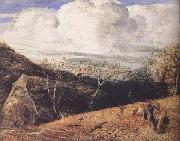Wholesale Oil Painting No Minimum |
|||||||||||
|
|
|||||||||||

|
|||||||||||
|
|
|
||||||||
Samuel Palmer1805-1881 British Samuel Palmer Galleries English painter, draughtsman and etcher. Palmer was a key figure of English Romantic painting who represented, at least in his early work, its pastoral, intuitive and nostalgic aspects at their most intense. He is widely described as a visionary and linked with his friend and mentor William Blake, though he stood at an almost opposite extreme in his commitment to landscape and his innocent approach to its imagery. He had none of Blake irony or complexity and was inspired by a passionate love of nature that found its philosophical dimension in unquestioning Neo-Platonism. |
||||||||
|
|
||||||||
The White Cloud
The White Cloud Painting ID:: 26396 |
mk49
c.1833-4
Oil and tempera,transferred from millboard to canvas
mk49 c.1833-4 Oil and tempera,transferred from millboard to canvas |
|||||||
|
|
||||||||
|
George Catlin 1796-1872 George Catlin Galleries Catlin was born in Wilkes-Barre, Pennsylvania. Following a brief career as a lawyer, he produced two major collections of paintings of American Indians and published a series of books chronicling his travels among the native peoples of North, Central and South America. Claiming his interest in America??s 'vanishing race' was sparked by a visiting American Indian delegation in Philadelphia, he set out to record the appearance and customs of America??s native people. Catlin began his journey in 1830 when he accompanied General William Clark on a diplomatic mission up the Mississippi River into Native American territory. St. Louis became Catlin??s base of operations for five trips he took between 1830 and 1836, eventually visiting fifty tribes. Two years later he ascended the Missouri River over 3000 km to Ft Union, where he spent several weeks among indigenous people still relatively untouched by European civilization. He visited eighteen tribes, including the Pawnee, Omaha, and Ponca in the south and the Mandan, Cheyenne, Crow, Assiniboine, and Blackfeet to the north. There, at the edge of the frontier, he produced the most vivid and penetrating portraits of his career. Later trips along the Arkansas, Red and Mississippi rivers as well as visits to Florida and the Great Lakes resulted in over 500 paintings and a substantial collection of artifacts. When Catlin returned east in 1838, he assembled these paintings and numerous artifacts into his Indian Gallery and began delivering public lectures which drew on his personal recollections of life among the American Indians. Catlin traveled with his Indian Gallery to major cities such as Pittsburgh, Cincinnati, and New York. He hung his paintings ??salon style????side by side and one above another??to great effect. Visitors identified each painting by the number on the frame as listed in Catlin??s catalogue. Soon afterwards he began a lifelong effort to sell his collection to the U.S. government. The touring Indian Gallery did not attract the paying public Catlin needed to stay financially sound, and Congress rejected his initial petition to purchase the works, so in 1839 Catlin took his collection across the Atlantic for a tour of European capitals. Catlin the showman and entrepreneur initially attracted crowds to his Indian Gallery in London, Brussels, and Paris. The French critic Charles Baudelaire remarked on Catlin??s paintings, ??M. Catlin has captured the proud, free character and noble expression of these splendid fellows in a masterly way.?? Catlin??s dream was to sell his Indian Gallery to the U.S. government so that his life??s work would be preserved intact. His continued attempts to persuade various officials in Washington, D.C. failed. He was forced to sell the original Indian Gallery, now 607 paintings, due to personal debts in 1852. Industrialist Joseph Harrison took possession of the paintings and artifacts, which he stored in a factory in Philadelphia, as security. Catlin spent the last 20 years of his life trying to re-create his collection. This second collection of paintings is known as the "Cartoon Collection" since the works are based on the outlines he drew of the works from the 1830s. In 1841 Catlin published Manners, Customs, and Condition of the North American Indians, in two volumes, with about 300 engravings. Three years later he published 25 plates, entitled Catlin??s North American Indian Portfolio, and, in 1848, Eight Years?? Travels and Residence in Europe. From 1852 to 1857 he traveled through South and Central America and later returned for further exploration in the Far West. The record of these later years is contained in Last Rambles amongst the Indians of the Rocky Mountains and the Andes (1868) and My Life among the Indians (ed. by N. G. Humphreys, 1909). In 1872, Catlin traveled to Washington, D.C. at the invitation of Joseph Henry, the first secretary of the Smithsonian. Until his death later that year in Jersey City, New Jersey, Catlin worked in a studio in the Smithsonian ??Castle.?? Harrison??s widow donated the original Indian Gallery??more than 500 works??to the Smithsonian in 1879. The nearly complete surviving set of Catlin??s first Indian Gallery painted in the 1830s is now part of the Smithsonian American Art Museum's collection. Some 700 sketches are in the American Museum of Natural History, New York City. The accuracy of some of Catlin's observations has been questioned. He claimed to be the first white man to see the Minnesota pipestone quarries, and pipestone was named catlinite. Catlin exaggerated various features of the site, and his boastful account of his visit aroused his critics, who disputed his claim of being the first white man to investigate the quarry. Previous recorded white visitors include the Groselliers and Radisson, Father Louis Hennepin, Baron LaHonton and others. Lewis and Clark noted the pipestone quarry in their journals in 1805. Fur trader Philander Prescott had written another account of the area in 1831. The White Cloud The White Cloud, Head Chief of the Iowas |
||||||||
|
|
||||||||
|
Prev Next
|
||||||||
|
|
||||||||
|
Related Paintings to George Catlin :. |
||||||||
|
|
||||||||
|
CONTACT US |

